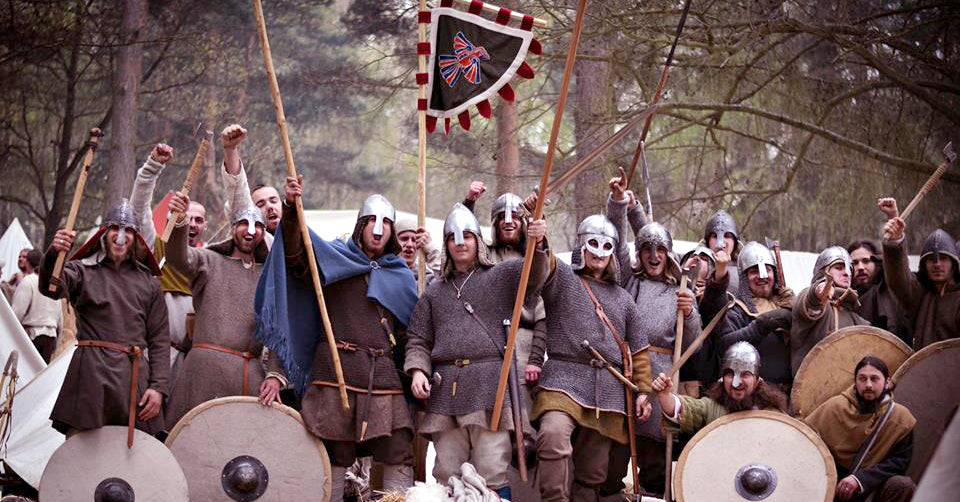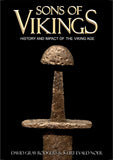Thanks for visiting our blog! As a thank-you, enjoy 15% off your first order in our online Viking Shop with the discount code BLOG15.
Editor's note: Just as Norwegian and Danish Vikings once ruled Dublin of Ireland, Kiev and other Slavic areas were once ruled by Swedish Vikings. A common belief is that the word Russia is based on the word Rus. According to the most prominent theory, the name Rus is based on the Finnish name for Sweden (Ruotsi), and is also Old Norse for "the men who row". The above photograph is of the author of this article and his fellow Slavic reenactors taking pride in their Viking heritage.
The presence of Nordic Scandinavians in what is now Russia, Ukraine and Belarus is proven by more than a hundred years of extensive archaeological excavations, as well as contemporary DNA research. These early medieval Scandinavians were known as the Rus, and through military and economic might formed an elite ruling class over Eastern Slavic tribes centered in Kiev in modern-day Ukrain. In this short article, we would like to focus on the meaning of the word Rus and the nature of Scandinavian activities in Eastern Europe.

Even before the well-known Viking Age, Scandinavians were adept ship builders, navigators, and sailors. The distinct advantage of these skills was applied for trade and other means of enrichment. By the 8th century (around the beginning of the Viking Era), Scandinavians Vikings controlled the trade in the Baltic sea, expanding constantly to new and more distant markets. Though first contact between the Scandinavians and the Baltic must have occurred in pre-history, Viking raiding and trading in the east greatly accelerated during the 8th and 9th century.
"The only occupation of Rus is the trade with sable, squirrel and other furs. They harry the Slavs, using ships to reach them; they carry them off as slaves and sell them. They have no fields but simply live on what they get from the Slav's lands." - Ibn Rustah
The Rus
The word Rus is found in Arabic, Byzantine, Frankish, Persian and Russian sources. It occurs in the variants Rus, Rus', Rhos, Ruzi, Rūsiyyah and others. Despite the recent notion that the word Rus (which can mean “red”) describes the Vikings’ red hair, the term itself is probably derived of Old Norse róðsmenn, which means "rowers". Some researchers suspect peoples by The Gulf of Finland adopted the original Swedish nomenclature. In Nestor's Primary Chronicle, it is said that the tribe of Rus dwelled beyond the sea, meaning Sweden. Interestingly, modern Finnish and Estonian words for Sweden are Ruotsi and Rootsi. As Swedes moved more and more eastward, the Finnish term was probably copied and changed by other people who had the chance to meet them, spreading the word Rus and bringing it to the masses. From this perspective, the Rus developed a reputation that was well-known throughout Europe.
While the oldest variant of the word Russia is known from the 10th century, the first mention of the word Rus comes from the Frankish Empire around 839 AD. At that time, Rus accompanied Byzantine messengers to negotiate with the Emperor Louis the Pious. Louis discerned that these bodyguards of the messengers were Scandinavians and as Vikings were currently terrorizing Frankish coasts and waterways, he considered them to be spies of the enemy.
So, as far as we can judge, the word Rus denotes people of Swedish ethnicity, especially men. The DNA analysis of the Rurikid dynasty, the most prominent house of Russian princes, proved to be directly connected to Sweden.
The Varangians
We must define the word Varangian as well. The current trend amongst historians is to (erroneously) call every Eastern Viking a Varangian. In later Russian sources, Varangians are inaccurately described as members of a Scandinavian tribe. However, the term really comes from Old Norse væringi, literally meaning "sworn companion". Unlike the more general word Rus, Varangian signifies a mercenary willing to serve in a foreign army. Units of foreign bodyguards were popular in the Early Middle Ages (and indeed, back to Roman times), as such men were more loyal to the ruler because they had no local political interests.
The Varangian Guard of the Byzantine Empire gained brilliant renown. However, it is hard to tell when the term Varangian first came into use, and to what extent it should be applied. Some authors think the earliest mention comes from 911 AD, when the Kievan Rus and the Byzantine Empire made a treaty. At that time, several hundred Rus warriors went to serve in Byzantium, though they did not yet form the famous Varangian Guard of the emperors. Other scholars think that the Varangian Guard was first formed after Prince Vladimir, who escaped from Kievan Rus to Sweden around 977 A.D., returned with thousands of mercenaries and conquered the capital city of Kiev (now known as Kyiv in modern-day Ukraine). In 988 A.D., Vladimir sent 6000 warriors to Byzantium (to strengthen his alliance with the super power). This marked the real beginning of the Varangian Guard, which lasted at least to the 13th century.
The Varangian Guard became a magnet for brave Vikings seeking adventure and riches in the Mediterranean and the fabled lands of the East. Great heroes like Harald Hardrada would make their names and fortunes there. Later, the Varangian Guard served as a destination for Nordic warriors who could not find a suitable place for their talents anywhere else, including Saxons and Danes fleeing from the demise of Viking England and Ireland after the battles of Clontarf and Hastings marked the setting sun of the Viking Age. This exodus of sword skill from the North was lamented by one Swedish source, that describes a moment when there were almost no young men left, since most of them went abroad to be mercenaries. In Uppland, (central Sweden), we can find dozens of runestones bearing names of Varangians that never came back home. Service abroad offered the chance for extravagant profit, but also mortal danger. Our ancestors deserve respect for being brave enough, as well as for their many other admirable qualities.
From Rus to Russia
As rich Vikings, mostly Swedes, gradually began to build fortified camps along their trade routes, some settled down, establishing a huge network of contacts, collecting taxes and tribute. In the 10th century, these activities transformed into a state-like entity we now call the Kievan Rus. Generally speaking, Kievan Rus could be considered to be the by-product of Scandinavian trade. It is probable that early rulers of sites like Gnezdovo belonged to the Swedish dynasty which controlled proto-towns, like the famous settlement of Birka. Maybe that's why the material culture of these sites, located 600 miles from each other, is so similar. We must stress, though, that the native tribes inhabiting the lands of the Kievan Rus were Slavic and Finno-Ugric peoples.

In several generations, the Scandinavian elements assimilated, but they were still aware of their origin. For Swedes, the region of Ladoga and Novgorod remained an area of interest for a very long time. Not only did many Swedish princesses marry Russian noblemen, but there were also massive efforts to reconquer this territory up through the 18th century. All these aspects bear witness to how Swedes understood their participation in the building of the Russian state, and the link between the Russians and their Viking ancestors.
Curious about your own true heritage?
Most people know where their grandparents are from, but where are THEIR grandparents from? You might be surprised. DNA test results have come a long way and can now trace the various journeys of your ancestors going back over a thousand years. For quality results (the most comprehensive ancestry breakdown on the market), we highly recommend using 23andMe. Please note that if you end up making a purchase, we may earn a small commission at no extra cost to you.
Author
Thomas Vlasaty, Prague, Czech Republic

Sons of Vikings is an online store offering hundreds of Viking inspired items, including Viking jewelry, Viking clothing, Drinking horns, home decor items and more.
To learn more about Viking history, we recommend our 400+ page, self titled book that is available here.
Share this article on social media:


